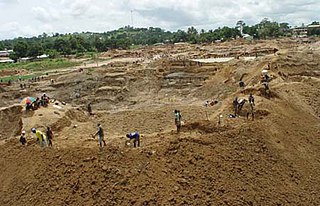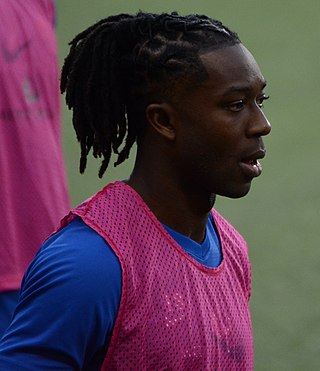Sierra Leone Labour Congress | |
| Founded | 1976 |
|---|---|
| Headquarters | Freetown, Sierra Leone |
| Location | |
Key people | [M. A. Deen ], President Kandeh Yilla, General Secretary |
| Affiliations | ITUC |
The Sierra Leone Labour Congress (SLLC) is a national trade union center in Sierra Leone. It was founded in 1976.
The SLLC is affiliated with the International Trade Union Confederation.
James Baimba Kabia was Secretary General from 1977 to 1981.[ citation needed ] [1]

Sierra Leone, officially the Republic of Sierra Leone, is a country on the southwest coast of West Africa. It is bordered to the southeast by Liberia and by Guinea to the north. Its land area is 71,740 km2 (27,699 sq mi). It has a tropical climate and environments ranging from savannas to rainforests. As of the 2023 census, Sierra Leone has a population of 8,908,040. Freetown is both its capital and its largest city. The country is divided into five administrative regions, which are further subdivided into 16 districts.
Sierra Leone first became inhabited by indigenous African peoples at least 2,500 years ago. The Limba were the first tribe known to inhabit Sierra Leone. The dense tropical rainforest partially isolated the region from other West African cultures, and it became a refuge for peoples escaping violence and jihads. Sierra Leone was named by Portuguese explorer Pedro de Sintra, who mapped the region in 1462. The Freetown estuary provided a good natural harbour for ships to shelter and replenish drinking water, and gained more international attention as coastal and trans-Atlantic trade supplanted trans-Saharan trade.

The economy of Sierra Leone is $7.41 billion by gross domestic product as of 2024. Since the end of the Sierra Leone Civil War in 2002, the economy is gradually recovering with a gross domestic product growth rate between 4 and 7%. In 2008 it in PPP ranked between 147th by World Bank, and 153rd by CIA, largest in the world.

Sierra Leone maintains formal relations with many Western nations. It also maintains diplomatic relations with the former Soviet Bloc countries as well as with the People's Republic of China.

Isaac Theophilus Akunna Wallace-Johnson was a Sierra Leonean, British West African workers' leader, journalist, activist and politician.

Islam is the largest and majority religion in Sierra Leone. Based on the 2015 Pew Research Center research, 78% of Sierra Leone's population is Muslim. The vast majority of Sierra Leonean Muslims are adherents of Sunni Islam.
The Sierra Leone Confederation of Trade Unions (TUC-SL) is a national trade union center in Sierra Leone. It was founded in 1996.

Kambia District is a district in the North West Province of Sierra Leone. Its capital and largest city is the town of Kambia. As of the 2015 census, The District had a population of 343,686. Kambia District borders the Republic of Guinea to the north, Port Loko District to the south and Karene District to the east. The district provides an important Trade route to or from the Sierra Leonean capital Freetown to the Guinean capital Conakry.

Tourism in Sierra Leone is an important growing national service industry. Beaches and other natural habitats are the biggest parts of the nation's tourism industry.

Sierra Leone – United States relations are bilateral relations between Sierra Leone and the United States.

Michael Lahoud is a Sierra Leonean former footballer and former broadcaster for Austin FC and current broadcaster for CBS Sports Golazo Network.. He also holds American citizenship.
Fula people of Sierra Leone is the fourth major ethnic group in Sierra Leone after the Temne, Mende and Limba ethnic groups and a branch of the Fula people of West Africa. The Fula make up about 3.4% of Sierra Leone's population. The Sierra Leone Fula people settled in the Western Area region of Sierra Leone more than four hundred years ago as settlers from the Fouta Djallon Kingdom that expanded to northern Sierra Leone.

Child labour in the diamond industry is a widely reported and criticized issue on diamond industry for using child labour in diamond mines and polishing procedures in poor conditions mainly in India and Africa. In these mines, children come in contact with minerals, oil and machinery exhaust. In 1997, The International Confederation of Free Trade Unions claimed that child labour was prospering in the diamond industry in Western India, where the majority of the world's diamonds are cut and polished while workers are often paid only a fraction of 1% of the value of the stones they cut. It is argued that economic growth in Western India in the 1980s–90s was associated with an increase in the number of child workers who do simple, repetitive manual tasks that do not require long years of training or experience in low-paying hazardous working conditions that involve drudgery, and foreclose the option of school education for most of them.

The mining industry of Sierra Leone accounted for 4.5 percent of the country's GDP in 2007 and minerals made up 79 percent of total export revenue with diamonds accounting for 46 percent of export revenue in 2008. The main minerals mined in Sierra Leone are diamonds, rutile, bauxite, gold, iron and limonite.

Visitors to Sierra Leone must obtain an e-Visa unless they are citizens of one of the visa-exempt countries or citizens who may obtain a visa on arrival.
Samuel Samo was a Dutch slave trader who was the first person to be prosecuted under the British Slave Trade Felony Act 1811.
Sir Alexander Ransford Slater was a British colonial administrator, who served as governor of Sierra Leone, the Gold Coast and Jamaica.
The Gambian Creole people, or Krio or Aku, are a minority ethnic group of Gambia with connections to and roots from the Sierra Leone Creole people. In Gambia the Aku account for about 2% of the population. Some estimates put the figure higher. However, according to the 2013 Gambian Census, the Aku make up 0.5% of the population or around 8,477 people.
Sierra Leonean nationality law is regulated by the Constitution of Sierra Leone, as amended; the Citizenship Act, and its revisions; and various international agreements to which the country is a signatory. These laws determine who is, or is eligible to be, a national of Sierra Leone. The legal means to acquire nationality, formal legal membership in a nation, differ from the domestic relationship of rights and obligations between a national and the nation, known as citizenship. Nationality describes the relationship of an individual to the state under international law, whereas citizenship is the domestic relationship of an individual within the nation. In Britain and thus the Commonwealth of Nations, though the terms are often used synonymously outside of law, they are governed by different statutes and regulated by different authorities. Sierra Leonean nationality is based on descent from a person who is Negro-African, regardless of whether they were born in Sierra Leone, jus soli, or abroad to a Sierra Leonean, jus sanguinis. The Negro clause was inserted based upon the founding of the colony as a refuge for former slaves to prevent economically powerful communities from obtaining political power. It can be granted to persons with an affiliation to the country, or to a permanent resident who has lived in the country for a given period of time through naturalisation.
Trade unions in Sierra Leone first emerged in the period around World War I, with reports indicating that civil servants organised unions as early as 1912. The Railway Workers Union was founded in 1919. In the late 1930s, trade unions affiliated to the Youth League formed the Trade Union Congress (TUC) to coordinate actions within the labour movement. In 1940, trade unions were legalised. In 1946 tripartite bargaining councils were established that incorporated trade unions for minimum wage and sectoral bargaining with employers. The Sierra Leone Labour Congress (SLLC) was founded in 1976. Although the country's civil war at the end of the 20th Century had a devastating effect on the labour movement, unions played an important role in nonviolent resistance, launching a national strike in the immediate aftermath of the 1997 coup by the Armed Forces Revolutionary Council. Since the end of the civil war, trade unionism in the informal sector has grown.